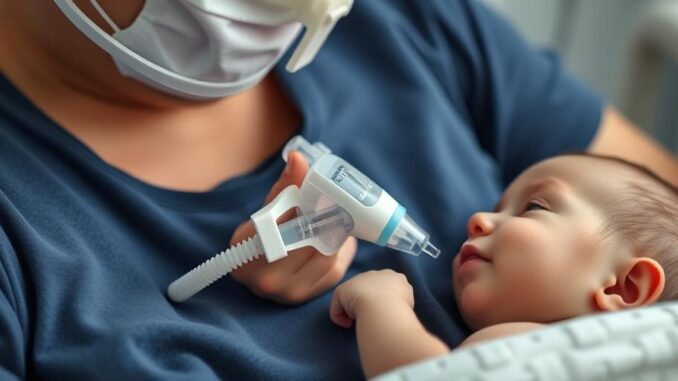
Summary
A recent study found that extending continuous positive airway pressure (CPAP) treatment for preterm infants significantly improves lung growth and function. This simple intervention offers a promising new approach to improving long-term respiratory health for vulnerable newborns. Researchers suggest this change in practice could have a global impact on preterm infant care.
Reliability and uptime matter in healthcare TrueNAS provides 24/7 support when it counts.
** Main Story**
Breathing Easier: New Study Finds Extended CPAP Improves Lung Growth in Preterm Infants
Premature birth presents numerous challenges for newborns, especially regarding lung development. Preterm infants often experience underdeveloped lungs, increasing their risk of respiratory problems throughout their lives. Now, a groundbreaking study offers a beacon of hope, revealing a simple yet effective method for promoting healthy lung growth in these vulnerable infants. Researchers at Oregon Health & Science University (OHSU) have found that extending the duration of continuous positive airway pressure (CPAP) treatment significantly improves lung growth and function in preterm infants. This discovery, published in the American Journal of Respiratory and Critical Care Medicine, has the potential to transform neonatal care and improve the long-term respiratory health of millions of children.
The Promise of Extended CPAP: A Simple Solution with Profound Impact
CPAP, a non-invasive respiratory support technique, delivers pressurized air through nasal prongs or a mask to keep the airways open. It’s standard practice for preterm infants experiencing respiratory distress. While early CPAP application is routine, doctors typically discontinue treatment once the infant’s breathing stabilizes. The OHSU research team questioned this conventional approach, hypothesizing that extending CPAP duration could further enhance lung development. They designed a randomized controlled trial involving 100 stable preterm infants. The researchers extended CPAP treatment for an additional two weeks beyond the typical duration. The results were striking. Infants receiving extended CPAP demonstrated significantly larger lung volumes at six months post-discharge, indicating substantial lung growth improvement. These infants also showed improved pulmonary gas exchange, more efficient oxygen and carbon dioxide diffusion in their lungs, and better overall airway function. Moreover, they experienced less wheezing throughout their first year.
Impact and Implementation: Changing Neonatal Care for the Better
These findings highlight the potential of a simple, non-pharmacological intervention to reshape the trajectory of lung disease in preterm infants. Dr. Cindy McEvoy, the study’s principal investigator and a professor of pediatrics at OHSU’s School of Medicine, emphasizes the transformative potential of this discovery. She states, “Adjusting the duration of CPAP application offers a safe and actionable method to positively influence lung development.” Extending CPAP therapy offers a cost-effective way to significantly improve outcomes, potentially reducing chronic respiratory illnesses, healthcare costs, and enhancing the quality of life for preterm infants. OHSU Doernbecher Children’s Hospital has already implemented this extended CPAP protocol in its NICU, witnessing positive results. Many NICUs across the country are now evaluating their CPAP practices based on these findings, signaling a potential shift in the standard of care for preterm infants. This research offers a powerful example of how a minor adjustment in clinical practice can produce significant benefits, providing a brighter future for preterm infants and their families.
Preterm Birth and Lung Development Challenges: A Broader Perspective
Preterm birth, defined as birth before 37 weeks of gestation, affects approximately 10% of births in the United States, translating to roughly 400,000 infants annually. The immature lungs of preterm infants face significant developmental challenges. These underdeveloped lungs often lack sufficient surfactant, a substance crucial for keeping the air sacs open. This deficiency can lead to respiratory distress syndrome (RDS), a serious condition characterized by labored breathing and low blood oxygen levels. Beyond RDS, preterm infants are at increased risk for bronchopulmonary dysplasia (BPD), a chronic lung disease that can require prolonged oxygen therapy and ventilation. Even after leaving the NICU, preterm infants remain vulnerable to respiratory infections, wheezing, and asthma, which can impact their long-term health and quality of life. Therefore, the findings of this study offer a significant step forward in mitigating these risks and providing preterm infants with a better chance of healthy lung development.


Given the potential global impact, what are the challenges anticipated in implementing this extended CPAP protocol in resource-limited settings, and what adaptations might be necessary?
That’s a crucial point! The study’s global impact truly hinges on accessibility. In resource-limited settings, equipment availability and staff training are significant hurdles. Perhaps simplified CPAP devices or task-shifting strategies could help make this life-saving intervention more widely available. What are your thoughts?
Editor: MedTechNews.Uk
Thank you to our Sponsor Esdebe
Extended CPAP, huh? So, are we talking about babies binge-watching Netflix with a breathing mask now? I wonder if this also helps with their binge-watching stamina later in life.
That’s a funny thought! While we’re not measuring Netflix stamina, the study showed that extended CPAP actually helps improve lung growth and function. Hopefully, this leads to healthier futures for these little ones, allowing them to breathe easier during all their future activities!
Editor: MedTechNews.Uk
Thank you to our Sponsor Esdebe
The study’s emphasis on extended CPAP and its impact on reducing wheezing in the first year post-discharge is particularly compelling. Could this intervention also influence the development of childhood asthma in these infants, and how might we track that potential long-term benefit?